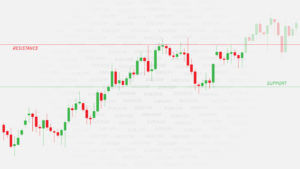Introduction
Williams Percent R is a momentum indicator developed by Larry Williams, which is similar to the Stochastic indicator. The Williams %R shows the position of the Close in relation to the highest high of the period.

Therefore, this oscillator moves from -100 to 0. Values below -80 are oversold levels while from -20 to 0 are overbought.
Some charting packages shift these values to positive 0 to 100 by adding 100 to the formula. In this case, oversold levels are between 0, and 20 and overbought condition happens from 80 to 100.
%R is noisier than Stochastic %D, but with less lag, so together with the confirming candle pattern, it allows for a better reward to risk ratio and tends to show more trade opportunities than Stochastic does.

Intraday trading is a dangerous profession. More than 85% of traders fail because they buy when they should sell and sell when they should buy. To those new to mean reverting markets, please welcome the Williams Percent R system!
The system rules are rather straightforward:
Use the 10-14 period % R indicator, as in the above figure.
For long entries:
1.- Wait for the %R line to enter the oversold territory ( -80 to -100)
2.- Go long the next candle whose %R line is above -60
3.- handle your trade using a trailing stop of about 0.3%
3.- let it run until % R reaches overbought then tighten your trail stop, but let the market take you out.
For short entries:
1.- Wait for the %R line to enter the overbought territory ( -20 to 0)
2.- Go short the next candle whose %R line is below -30
3.- handle your trade using a trailing stop of about 0.3%
3.- let it run until % R reaches oversold then tighten your trail stop, but let the market take you out.
Backtesting a Williams %R system
We used the 10-period Williams %R signal, a 0.37% Trail stop and a 0.8% target on a 14-year 1h data of the EUR-USD. Below, the total trade analysis table and the equity curve using a constant one lot trade. That is the standard way to assess the quality of a system. The important parameter here is not the amount won, but its statistical characteristics and curve smoothness.
This system delivers close to 4 million euro along 14 years, using a proportional 1.5% risk sizing strategy, with about 35% drawdown. In the case of a one-lot contract, the drawdown is just 7%.
The percent profitable is very good, with an overall 48.11% of positive trades, although we observe that this grows to 58.27% on long trades and shrinks to 42.25% on short trades.
The ratio win/loss that measures the reward we get for the risk we hold is not spectacular, but it’s fairly good on a system with no filter to allow only trades with the primary trend.
The use of a trending filter.
Ideally, the use of a trending filter might improve the system, because it avoids trades against the main trend, and it does, but the results are a bit surprising. Although It improves the overall results, the percent of winning trades goes down to 41%. That figure is compensated with an increase in the ratio Win/loss to 1.8%, from the original 1.55%, Overall.
Main metrics of the Williams Percent-R System, on the EUR-USD:
How to use Metatrader 4 to trade the Williams %R scalper:
The Williams %R is an indicator that comes together with the basic MT4. To add it to a chart, we select that chart and then click Insert -> Indicators -> Oscillators -> Williams Percent Range
Then a popup window appears to allow range selection:
After that you’ll get everything configured to start working with this technique:
It’s not usual but, from time to time we may expect a streak of up to 10 losing trades. Therefore we need to apply proper money management.
As an example, let’s say, you don’t like to have a drawdown higher than 25% of your running capital. Then you need to divide that figure by 10, and that must be your maximum risk for a single trade, Therefore, in this case, this is 2.5% of the current capital allocated for this strategy.
© Forex.Academy















